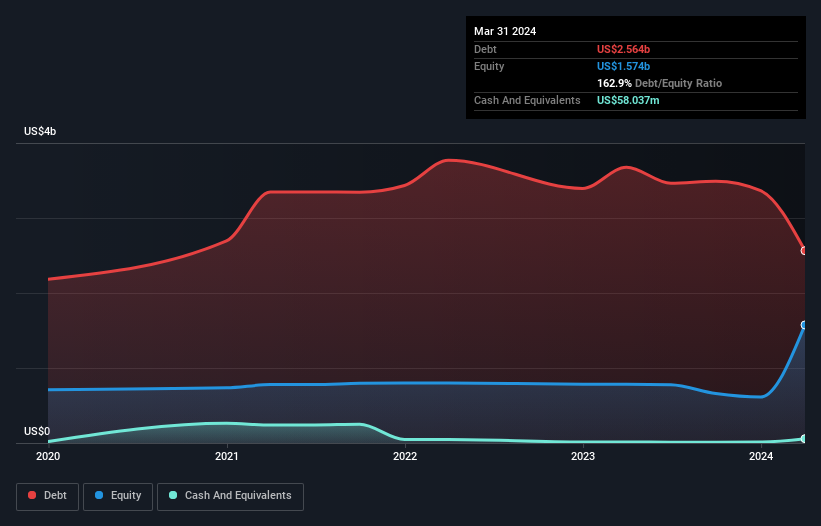- United States
- /
- Healthcare Services
- /
- NasdaqGS:BTSG
BrightSpring Health Services (NASDAQ:BTSG) Seems To Be Using A Lot Of Debt

Howard Marks put it nicely when he said that, rather than worrying about share price volatility, 'The possibility of permanent loss is the risk I worry about... and every practical investor I know worries about.' When we think about how risky a company is, we always like to look at its use of debt, since debt overload can lead to ruin. We note that BrightSpring Health Services, Inc. (NASDAQ:BTSG) does have debt on its balance sheet. But the more important question is: how much risk is that debt creating?
When Is Debt Dangerous?
Debt is a tool to help businesses grow, but if a business is incapable of paying off its lenders, then it exists at their mercy. Ultimately, if the company can't fulfill its legal obligations to repay debt, shareholders could walk away with nothing. However, a more usual (but still expensive) situation is where a company must dilute shareholders at a cheap share price simply to get debt under control. By replacing dilution, though, debt can be an extremely good tool for businesses that need capital to invest in growth at high rates of return. When we think about a company's use of debt, we first look at cash and debt together.
Check out our latest analysis for BrightSpring Health Services
What Is BrightSpring Health Services's Debt?
The image below, which you can click on for greater detail, shows that BrightSpring Health Services had debt of US$2.56b at the end of March 2024, a reduction from US$3.68b over a year. However, because it has a cash reserve of US$58.0m, its net debt is less, at about US$2.51b.

How Strong Is BrightSpring Health Services' Balance Sheet?
Zooming in on the latest balance sheet data, we can see that BrightSpring Health Services had liabilities of US$1.24b due within 12 months and liabilities of US$2.84b due beyond that. Offsetting these obligations, it had cash of US$58.0m as well as receivables valued at US$1.11b due within 12 months. So its liabilities total US$2.91b more than the combination of its cash and short-term receivables.
The deficiency here weighs heavily on the US$1.94b company itself, as if a child were struggling under the weight of an enormous back-pack full of books, his sports gear, and a trumpet. So we'd watch its balance sheet closely, without a doubt. After all, BrightSpring Health Services would likely require a major re-capitalisation if it had to pay its creditors today.
We measure a company's debt load relative to its earnings power by looking at its net debt divided by its earnings before interest, tax, depreciation, and amortization (EBITDA) and by calculating how easily its earnings before interest and tax (EBIT) cover its interest expense (interest cover). Thus we consider debt relative to earnings both with and without depreciation and amortization expenses.
BrightSpring Health Services shareholders face the double whammy of a high net debt to EBITDA ratio (8.2), and fairly weak interest coverage, since EBIT is just 0.33 times the interest expense. This means we'd consider it to have a heavy debt load. Even worse, BrightSpring Health Services saw its EBIT tank 52% over the last 12 months. If earnings continue to follow that trajectory, paying off that debt load will be harder than convincing us to run a marathon in the rain. There's no doubt that we learn most about debt from the balance sheet. But it is future earnings, more than anything, that will determine BrightSpring Health Services's ability to maintain a healthy balance sheet going forward. So if you want to see what the professionals think, you might find this free report on analyst profit forecasts to be interesting.
Finally, a company can only pay off debt with cold hard cash, not accounting profits. So we clearly need to look at whether that EBIT is leading to corresponding free cash flow. In the last three years, BrightSpring Health Services created free cash flow amounting to 16% of its EBIT, an uninspiring performance. That limp level of cash conversion undermines its ability to manage and pay down debt.
Our View
To be frank both BrightSpring Health Services's interest cover and its track record of (not) growing its EBIT make us rather uncomfortable with its debt levels. And furthermore, its level of total liabilities also fails to instill confidence. It's also worth noting that BrightSpring Health Services is in the Healthcare industry, which is often considered to be quite defensive. Considering all the factors previously mentioned, we think that BrightSpring Health Services really is carrying too much debt. To our minds, that means the stock is rather high risk, and probably one to avoid; but to each their own (investing) style. Given our concerns about BrightSpring Health Services's debt levels, it seems only prudent to check if insiders have been ditching the stock.
At the end of the day, it's often better to focus on companies that are free from net debt. You can access our special list of such companies (all with a track record of profit growth). It's free.
Valuation is complex, but we're here to simplify it.
Discover if BrightSpring Health Services might be undervalued or overvalued with our detailed analysis, featuring fair value estimates, potential risks, dividends, insider trades, and its financial condition.
Access Free AnalysisHave feedback on this article? Concerned about the content? Get in touch with us directly. Alternatively, email editorial-team (at) simplywallst.com.
This article by Simply Wall St is general in nature. We provide commentary based on historical data and analyst forecasts only using an unbiased methodology and our articles are not intended to be financial advice. It does not constitute a recommendation to buy or sell any stock, and does not take account of your objectives, or your financial situation. We aim to bring you long-term focused analysis driven by fundamental data. Note that our analysis may not factor in the latest price-sensitive company announcements or qualitative material. Simply Wall St has no position in any stocks mentioned.
Have feedback on this article? Concerned about the content? Get in touch with us directly. Alternatively, email editorial-team@simplywallst.com
About NasdaqGS:BTSG
BrightSpring Health Services
Operates as a home and community-based healthcare services platform in the United States.
Very undervalued with moderate growth potential.
Similar Companies
Market Insights
Community Narratives



